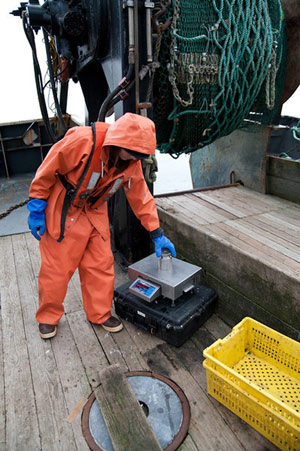West Coast Catch Share Program Sees Conservation & Economic Benefits in First Year

Sorting trawl-caught fish on deck.
Catch monitor Ian Cole (left) inspecting catch as it is off loaded. Image credit: Pacific States Marine Fisheries Commission.

Catch share observer from the West Coast Groundfish Observer Program calibrating a scale on deck before sampling and weighing fish.
July 19, 2012 In 2006, Congress made the decision to end overfishing in our Nation’s waters and amended the Magnuson-Stevens Fisheries Conservation and Management Act to require annual catch limits for all federally managed fisheries. Though overfishing had already ceased on the West Coast, this directive led to a new management program to protect the region’s rebounding groundfish stocks. In 2011, the Pacific Fisheries Management Council and NOAA Fisheries implemented the West Coast Groundfish Trawl Catch Share Program.
In 2006, Congress made the decision to end overfishing in our Nation’s waters and amended the Magnuson-Stevens Fisheries Conservation and Management Act to require annual catch limits for all federally managed fisheries. Though overfishing had already ceased on the West Coast, this directive led to a new management program to protect the region’s rebounding groundfish stocks. In 2011, the Pacific Fisheries Management Council and NOAA Fisheries implemented the West Coast Groundfish Trawl Catch Share Program.
In just one year, the program has become a national model for sustainable fisheries management that ensures overfishing is behind us, provides stability to the fishing industry, and supports the fishing infrastructure of many Pacific coastal communities. Read the report here.
The Advantages of Catch Shares
Under the new program, fishermen or other groups are given exclusive access to catch a certain percentage of the overall annual quota of fish. Rather than the traditional “derby” model where fishermen rush to catch as many fish as possible, catch shares allow fishermen to spread their fishing activity over a longer period of time because no one else is allowed to catch their quota.
This has several advantages. It allows for steadier work, resulting in a more consistent market and better prices for fishermen—catch is no longer flooding the market but now is available year-round. Another advantage is resource conservation. Fishermen are individually accountable for all species they bring aboard their vessel, and the catch is deducted from their annual quota. As a result, fishermen work to ensure they are catching their targeted stocks and not inadvertently catching other marine species, or bycatch. Under the prior fishing model, time pressures and competition meant that fishermen did not have the luxury of such a strategic approach.
Good Results from the First Year
This month, NOAA Fisheries released a report documenting the results from the first year of the West Coast Catch Share Program, the 2011 season. So what does the data tell us? Results indicate that revenues are up, bycatch is down, and fishing is extended later in the season. Revenues reached a total of $54 million in 2011. This is well above the average annual revenue from 2006 to 2010, which was only $38 million.
Fishermen are also fishing more efficiently and later in the season. December historically is a down time, but in 2011 catch was up 71 percent from the 2006 to 2010 seasons. This is attributed to the fact that fishermen feel secure that they won’t exceed their quota or bycatch limits. Program-wide, fishermen significantly reduced bycatch. In the whiting fleet, for example, bycatch of canary rockfish was reduced by 79 percent, and for Pacific Ocean perch, the reduction was 96 percent.
Taken together, these results indicate that sustainably managed fisheries can contribute to economic stability for fishing communities and contribute to the health of our shared marine resources.
Program Exceeded Our Expectations
One year into implementation, the West Coast Groundfish Trawl Catch Share Program has set the stage for sound, sustainable management of our fisheries. According to Brad Pettinger, director of the Oregon Trawl Commission, “The first year of the catch share program exceeded most people’s expectations. One of the biggest changes was in the reduction of discarded fish, as personal accountability, coupled with the ability to trade quota pounds, really made a difference."
The program is one of the most transformative strategies in fishery management history. Collaboration among fishermen, the Pacific States Marine Fisheries Commission, the Pacific Fishery Management Council, West Coast states, and NOAA Fisheries contributed to the program’s successful development. Through continued partnership, we will have a fishery that supports coastal communities on the West Coast for years to come.


